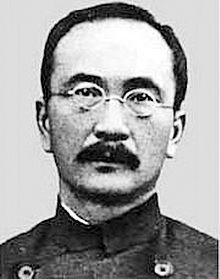Tang_Shaoyi
Tang Shaoyi
Chinese politician; first Premier of the Republic of China (1862–1938)
Tang Shaoyi (Chinese: 唐紹儀; 2 January 1862 – 30 September 1938), also spelled Tong Shao Yi, courtesy name Shaochuan (少川), was a Chinese statesman who briefly served as the first Premier of the Republic of China in 1912. In 1938, he was assassinated by the staff of the Bureau of Investigation and Statistics in Shanghai.
This article needs additional citations for verification. (July 2013) |
| |||||||||||||||
|---|---|---|---|---|---|---|---|---|---|---|---|---|---|---|---|
 | |||||||||||||||
| 1st Premier of the Republic of China | |||||||||||||||
| In office 5 August 1922 – 19 September 1922 | |||||||||||||||
| President | Li Yuanhong | ||||||||||||||
| Preceded by | Yan Huiqing | ||||||||||||||
| Succeeded by | Wang Chonghui | ||||||||||||||
| In office 13 March 1912 – 27 June 1912 | |||||||||||||||
| President | Yuan Shikai | ||||||||||||||
| Preceded by | Position established | ||||||||||||||
| Succeeded by | Lu Zhengxiang | ||||||||||||||
| 2nd Minister of Mail and Communications of the Imperial Cabinet | |||||||||||||||
| In office 26 October 1911 – 1 November 1911 | |||||||||||||||
| Monarch | Xuantong Emperor | ||||||||||||||
| Prime Minister | Yikuang, Prince Qing | ||||||||||||||
| Preceded by | Sheng Xuanhuai | ||||||||||||||
| Succeeded by | Position abolished | ||||||||||||||
| Personal details | |||||||||||||||
| Born | (1862-01-02)2 January 1862 Xiangshan County, Guangdong, Qing dynasty, China | ||||||||||||||
| Died | 30 September 1938(1938-09-30) (aged 76) Shanghai, Republic of China | ||||||||||||||
| Political party | Unity Party | ||||||||||||||
| Alma mater | Queen's College, Hong Kong Columbia University | ||||||||||||||
| Chinese name | |||||||||||||||
| Traditional Chinese | 唐紹儀 | ||||||||||||||
| Simplified Chinese | 唐绍仪 | ||||||||||||||
| |||||||||||||||
Tang was a native of Xiangshan County, Guangdong. Tang was educated in the United States, attending elementary school in Springfield, Massachusetts, and high school in Hartford, Connecticut.[1] He later studied at Queen's College, Hong Kong, and then Columbia University in New York on the Chinese Educational Mission. He was a member of Columbia College's class of 1882 before being recalled back to China by the Qing government.[2] Tong was a classmate and close friend of future Columbia president Nicholas Murray Butler.[3]
Tang was a friend of Yuan Shikai; and during the Xinhai Revolution, negotiated on the latter's behalf in Shanghai with the revolutionaries' Wu Tingfang, ending up with the recognition of Yuan as President of the Republic of China. He had been a diplomat with Yuan Shikai's staff in Korea.[1] In 1900, he was appointed head of the Shandong Bureau of Foreign Affairs under governor Yuan Shikai.[1]
Widely respected, he became the Republic's first Prime Minister in 1912, but quickly grew disillusioned with Yuan's lack of respect for the rule of law and resigned.[4] He later took part in Sun Yat-sen's government in Guangzhou. Tang Shaoyi opposed, on constitutional grounds, Sun's taking of the "Extraordinary Presidency" in 1921; Tang resigned from his position. In 1924, he refused an offer to be foreign minister under warlord Duan Qirui's provisional government in Beijing.
In 1937, Tang bought a house on Route Ferguson in the Shanghai French Concession and retired there.[5] The following year, the Japanese invaded and occupied Shanghai (though not yet the foreign concessions). Japanese general Kenji Doihara attempted to recruit Tang to become president of the new pro-Japanese puppet government, and Tang was willing to negotiate with the Japanese. The Kuomintang's intelligence agency Juntong learned about the negotiation, and its chief Dai Li ordered his assassination. On 30 September 1938, Tang was killed in his living room by a Juntong squad who pretended to be antique sellers.[6]
Tang Shaoyi's daughter Tang Baoyue (English name May Tang) was married to the prominent diplomat V. K. Wellington Koo. She died in October 1918 during the 1918 flu pandemic, after falling ill for only a week.[7] Another daughter Lora Tang was married to the well-known Singapore philanthropist Lee Seng Gee, former chairman of the Lee Foundation. Another daughter from his first wife, Isobel, was married to Henry K. Chang (Chang Chien), the Chinese Ambassador and Consul General at San Francisco (1929).[8]
- Wang, Ke-wen (1997). Modern China: an encyclopedia of history, culture, and nationalism. Routledge, London. p. 348. ISBN 9780203306345.
- Columbia University. Office of the President (1891). Annual report. Columbia University Libraries. [New York : The University].
- "Columbia and China in History | Columbia Global Centers". globalcenters.columbia.edu. Retrieved 2022-02-06.
- John Stuart Thomson (1913). China revolutionized. INDIANAPOLIS: The Bobbs-Merrill company. p. 105.
- 武康路与民国第一任总理唐绍仪血案 [Wukang Road and the assassination of Tang Shaoyi] (in Chinese). China.com.cn. 22 November 2012. Archived from the original on 17 January 2021. Retrieved 8 October 2013.
- Wakeman, Frederic E. (2002). The Shanghai Badlands: Wartime Terrorism and Urban Crime, 1937-1941. Cambridge University Press. p. 48. ISBN 9780521528719.
- Craft, Stephan G. (2004). V.K. Wellington Koo and the Emergence of Modern China. University Press of Kentucky. p. 45. ISBN 9780813127286.
- Hinners, David G. (1999). Tong Shao-Yi and His Family. University Press of America. p. 102. ISBN 0-7618-1392-6.
| Government offices | ||
|---|---|---|
| Preceded by New title |
Premier of the Republic of China 1912 |
Succeeded by |